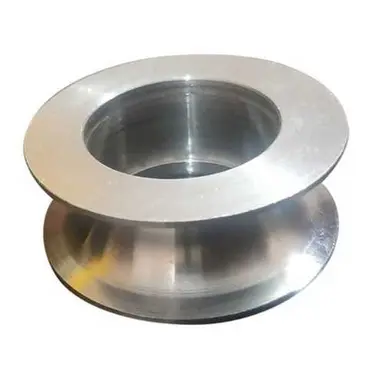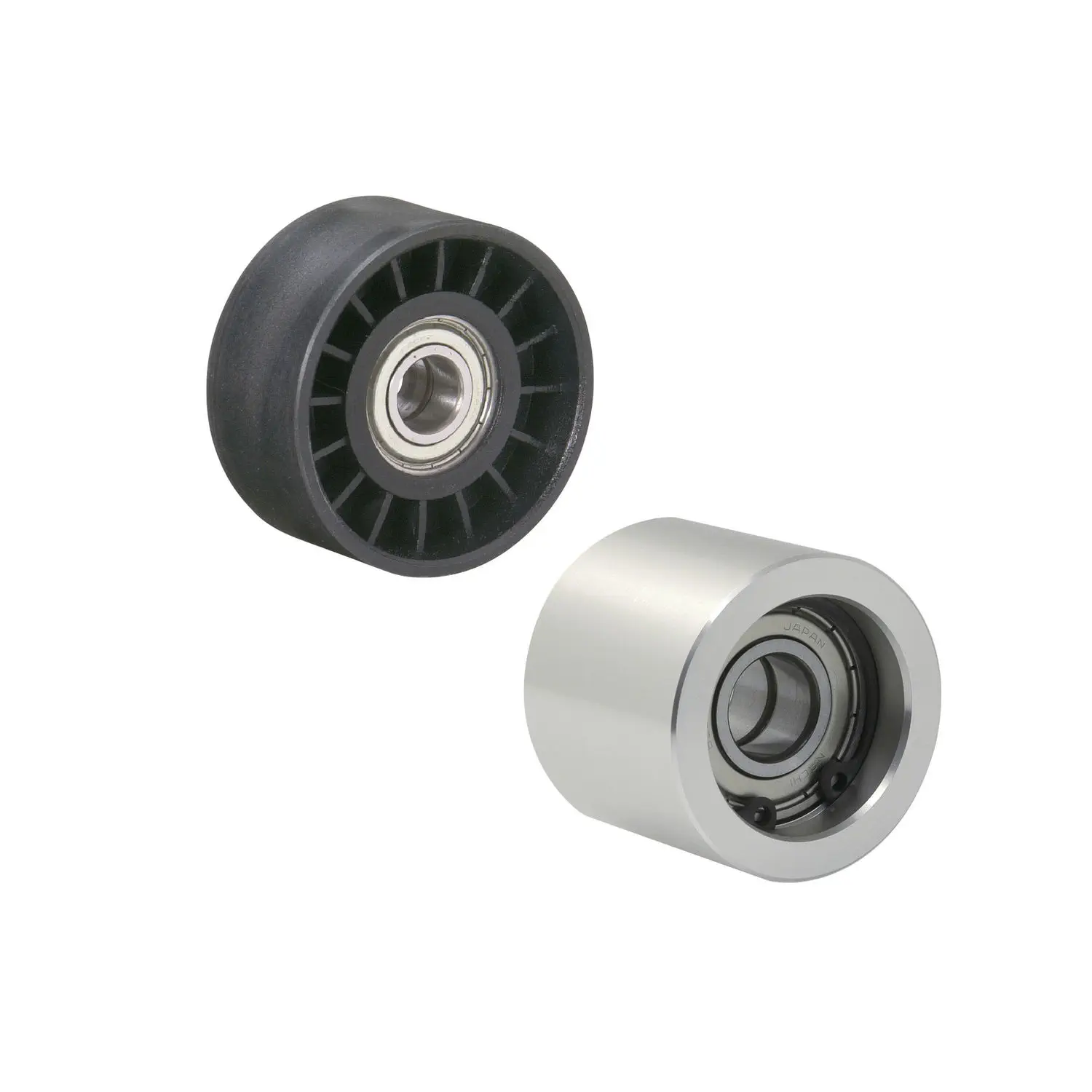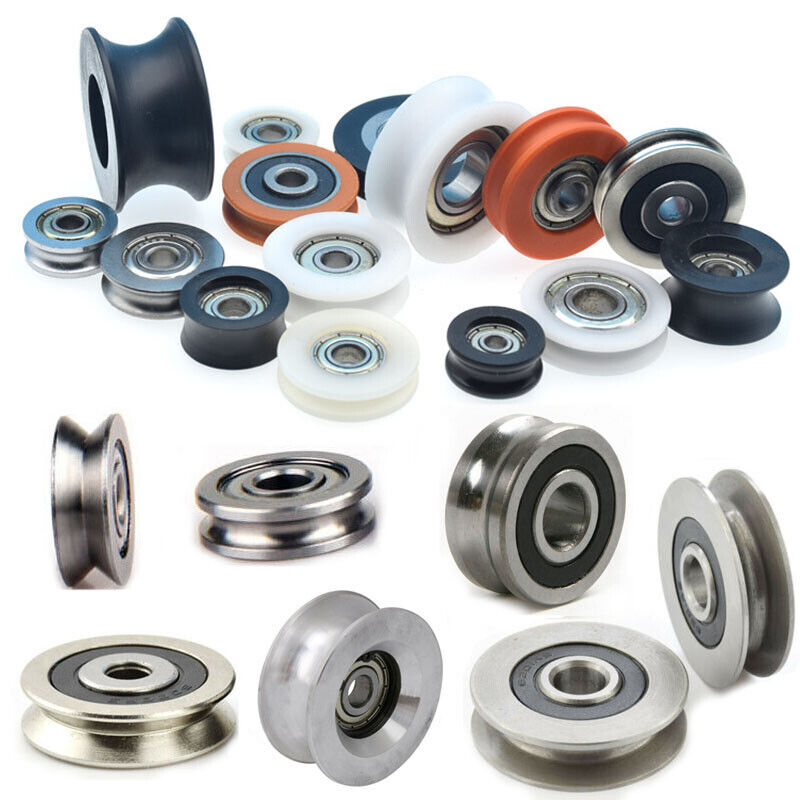Product Description
Head Drive Pulley, Return Pulley,Bend Pulley, Snub Pulley,Tensioning Pulley, Take up Pulley can be provided. We are designing and manufacturing pulleys, using materials of the highest quality in a production process employing advanced technology. This together with the application of the Quality Assurance system certifi ed to ISO 9001:2015, contributes to the production of high quality products offering dependable, long life performance in the field and appreciably reducing maintenance cost. Each our conveyor pulley is individually computer designed to meet the client’s requirements.
|
Product Name |
Belt Conveyor Pulley Drum |
||
|
Type |
Drive Pulley, Bend Pulley,Snub Pulley,Take Up Pulley | ||
|
Length |
200mm-2500mm |
||
|
Materials |
Carbon steel, Stainless steel, Rubber |
||
|
Surface Treatment |
Smooth, CHINAMFG grooved lagging, Herringbone lagging, Ceramic lagging |
||
|
Welding |
Submerged Arc Welding |
||
|
Bearing |
Famous brands |
||
|
Structure |
Tube,shaft,self-aligning bearing,bearing seat/house,hub, locking bushing,end disc |
||
Drive Pulley Introduction:
1. Head/Drive Pulley is located at the discharge terminus of the conveyor.
2. Drive pulley provides the driving force for the conveyor. In order to increase pulley life and traction, it often has a larger diameter than other pulleys.
3. We can supply pulleys with hot vulcanized rubber lagging, plain or grooved, as required by client. Different patterns of grooving such as herringbone or CHINAMFG can be provided to increase tractive friction under dirty or wet conditions. CHINAMFG grooves have the advantage of being installed in any orientation, regardless of belt direction.
Specification of Drive Head Pulley Drum
| Belt Width | 500-2800mm (19-110 inch) |
| Pulley Length | 500-3500mm (19-138 inch) |
| Diameter | 200-1800mm (8-70 inch) |
| Standard | ISO9001:2008, CEMA, DIN, TUV, JIS, AS/NS, etc. |
| Working Life | More than 30,000 hours. |
| Surface | Flat Rubber Lagged, Ceramic Lagged, CHINAMFG Rubber Lagged, etc. |
| Main Material | Carbon Steel |
| Length of conveyor drive pulley depends on the width of conveyor Belt. You can get drive pulleys with hot & cold vulcanized rubber lagging, plain or grooved, as required by client. | |
Bend Pulley Introduction:
1. The bend pulley is used for changing the direction of the belt.
2. The bend pulley is usually installed at the tail part or the vertical take-up equipment part when the belt direction need to 180°bending. It will be installed above the take-up equipment part while 90°bending.
3. The pulley, which is used for extending the contact surface, is usually used for below or equal to 45 degree bending.
4. The surface treatment of the bend pulley can be smooth steel and flat rubber lagging.
Specification of Bend Pulley:
| Belt Width | 500-2800mm(19-110 inch) |
| Pulley Length | 500-3200mm(19-126 inch) |
| Diameter | 200-1800mm(8-70 inch) |
| Standard | ISO9001:2008, CEMA, DIN, TUV, etc. |
| Working Life | More than 30,000 hours. |
| Surface | Flat Rubber Lagged, Ceramic Lagged, CHINAMFG Rubber Lagged, etc. |
| Main Material | Carbon Steel |
| Length of conveyor bend pulley depends on the width of conveyor Belt. You can get drive pulleys with hot vulcanized rubber lagging, plain or grooved, as required by client. | |
Snub Pulley
Snub pulley is used to achieve higher angle of wrap on the drive pulley thereby increasing the traction. It also reduces the belt tension maximizing the life of the conveyor component.It is mounted close to the drive pulley on the return side of the belt.
Specification of Snub Pulley:
| Items | Content |
| Belt Width | 500-2800mm (19-110 inch) |
| Pulley Length | 500-3200mm (19-126 inch) |
| Diameter | 200-1800mm (8-70 inch) |
| Standard | ISO9001:2008, CEMA, DIN, TUV, etc. |
| Working Life | More than 30,000 hours. |
| Surface | Flat Rubber Lagged, Ceramic Lagged, CHINAMFG Rubber Lagged, etc. |
| Main Material | Carbon Steel |
| Length of conveyor Snubpulley depends on the width of conveyor Belt. You can get Snubpulleys with hot vulcanized rubber lagging, plain or grooved, as required by client. | |
Take Up Pulley
The take up pulley will ensure adequate tension of the belt leaving the drive pulley so as to avoid any slippage of the belt, ensure proper belt tension at the loading and other points along the conveyor, compensate for changes in belt length due to elongation, and provide extra length of belt when necessary for splicing purpose.
Specification of take up pulley drum:
| Belt Width | 500-2800mm(19-110 inch) |
| Pulley Length | 500-3200mm(19-126 inch) |
| Diameter | 200-1800mm(8-70 inch) |
| Standard | ISO9001:2008, CEMA, DIN, TUV, etc. |
| Working Life | More than 30,000 hours. |
| Surface | Flat Rubber Lagged, Ceramic Lagged, CHINAMFG Rubber Lagged, etc. |
| Main Material | Carbon Steel |
The components of a pulley drum include the following:
| Drum or Shell | The drum is the portion of the pulley in direct contact with the belt. The shell is fabricated from either a rolled sheet of steel or from hollow steel tubing.The shell has a specific ‘face’ width and diameter which is determined by the width of the belting and the type and rating of the belt to be used on the conveyor. | |
| Diaphragm Plates | The diaphragm or end plates of a pulley are circular discs which are fabricated from thick steel plate and which are welded into the shell at each end, to strengthen the drum.The end plates are bored in their centre to accommodate the pulley shaft and the hubs for the pulley locking elements. | |
| Shaft | The shaft is designed to accommodate all the applied forces from the belt and / or the drive unit, with minimum deflection.The shaft is located and locked to the hubs of the end discs by means of a locking elements. The shaft is supported on both ends by bearings which are housed in plummer blocks, to support the shaft and pulley assembly on the conveyor structure. Shafts often comprise different diameters along their length due to the bending moments and resultant deflection limitations. The diameter of the shaft at the landings for the bearings may be smaller to satisfy the necessary bearing diameter which is more cost-effective (smaller). Similarly in the case of a drive shaft, the drive attachment, may be different to the other diameters along the shaft and hence pulley shafts are often stepped. |
|
| Locking Elements | These are high-precision manufactured items which are fitted over the shaft and into the pulley hubs. The locking elements attach the pulley firmly to the shaft via the end plates.Locking elements work on the friction-grip principle whereby the element is able to be fastened to the shaft and hub simultaneously and concentrically, by tightening a series of screws around the locking element. | |
| Hubs | The hubs are fabricated and machined housings which are welded into the end plates. The hubs are sized according to the size of the pulley, the diameter of the shaft and the size of the locking element which is required for the specific duty. | |
| Lagging | It is sometimes necessary or desirable to improve the friction between the conveyor belt and the pulley in order to improve the torque that can be transmitted through a drive pulley.Improved traction over a pulley also assists with the training of the belt. In such cases pulley drum surfaces are ‘lagged’ or covered in a rubberized material. This cover is usually 8 mm to 12 mm thick and can be plain or have a grooved pattern. The rubber lagging is vulcanized to the pulley shell to ensure that it remains attached under adverse operating conditions. |
|
| Bearing Assemblies | Bearings support the rotating shaft and hence the pulley. The bearings are housed in ‘plummer blocks’ which enable the mass of the pulley assembly plus the belt tension forces to be transmitted to the pulley supporting structure.Plummer blocks are often bolted to ‘sole plates’ which are welded to the structure. The sole plates incorporate jacking screws to enable the pulley to be correctly and relatively easily aligned. |
|
Several types of bearing housing, seals and end disc:
Pulley Drum Warehouse and package:
Pulley Drums:
Our Products: Belt Conveyors, Pulley Drum, Conveyor Rollers Idler, etc.
| Material: | Carbon Steel |
|---|---|
| Surface Treatment: | Baking Paint |
| Motor Type: | Frequency Control Motor |
| Installation: | Horizontal |
| Color: | as Customers′ Requirements |
| OEM: | Available |
| Customization: |
Available
| Customized Request |
|---|

Can roller pulleys be retrofitted into existing conveyor systems for improvements?
Yes, roller pulleys can be retrofitted into existing conveyor systems to achieve various improvements. Retrofitting roller pulleys offers several benefits and can address specific operational challenges. Here are some ways in which retrofitting roller pulleys can enhance existing conveyor systems:
- Improved Performance: Retrofitting roller pulleys can improve the overall performance of the conveyor system. By upgrading to modern roller pulleys with advanced features, such as low rolling resistance, improved load distribution, or specialized coatings, the system can achieve better material handling, increased throughput, and reduced energy consumption.
- Enhanced Efficiency: Retrofitting roller pulleys can enhance the efficiency of the conveyor system. By replacing worn-out or outdated rollers with new ones, the system can operate more smoothly and reliably. Roller pulleys with precision bearings, reduced friction, or self-cleaning capabilities can minimize material jams, reduce maintenance requirements, and optimize the overall efficiency of material handling processes.
- Noise Reduction: Roller pulleys with noise-dampening features can be retrofitted to reduce the noise levels generated by the conveyor system. This is particularly beneficial in environments where noise reduction is a priority, such as warehouses located near residential areas or workplaces where a quieter atmosphere is desired.
- Increased Durability: Retrofitting roller pulleys can enhance the durability and longevity of the conveyor system. Upgrading to roller pulleys made from more robust materials or featuring improved corrosion resistance can extend the lifespan of the equipment, reducing the frequency of replacements and minimizing downtime due to maintenance or repairs.
- Compatibility with Upgrades: Retrofitting roller pulleys allows for compatibility with other upgrades or modifications to the conveyor system. For example, if the system is being upgraded with automation technologies, such as robotics or AGVs, roller pulleys can be retrofitted to ensure seamless integration and precise material handling between the conveyor system and the automated equipment.
- Cost-Effective Solution: Retrofitting roller pulleys is often a cost-effective solution compared to replacing the entire conveyor system. By selectively upgrading critical components, such as the roller pulleys, operators can achieve significant improvements in performance and efficiency while avoiding the expense of a complete system replacement.
Before retrofitting roller pulleys, it is essential to assess the compatibility of the existing conveyor system and ensure that the retrofitted components meet the specific requirements and constraints of the operation. Consulting with roller pulley manufacturers or industry experts can provide valuable guidance in selecting the appropriate roller pulleys and executing a successful retrofitting process.

What role do roller pulleys play in controlling the direction and flow of materials?
Roller pulleys play a crucial role in controlling the direction and flow of materials in conveyor systems. They contribute to the efficient and reliable movement of materials along the desired path. Here’s how roller pulleys accomplish this:
- Change of Direction: Roller pulleys are used to change the direction of the conveyor belt, allowing materials to move along curved or angled paths. By using a combination of different-sized roller pulleys and carefully designed conveyor geometry, materials can be smoothly redirected as needed.
- Belt Tension and Tracking: Roller pulleys help maintain proper tension and tracking of the conveyor belt. Tensioning pulleys, also known as snub or take-up pulleys, are used to apply tension to the belt, ensuring it remains properly aligned and taut. Tracking pulleys, such as crowned or V-shaped pulleys, assist in keeping the belt centered and preventing it from drifting off-course.
- Controlled Material Flow: The arrangement and spacing of roller pulleys influence the material flow on the conveyor belt. By strategically positioning rollers, it is possible to create gentle inclines or declines, control the speed of material movement, and prevent material accumulation or blockages.
- Impact and Damage Reduction: Roller pulleys, particularly impact rollers, help absorb the impact of heavy or sharp-edged materials as they land on the conveyor belt. They cushion the impact, reducing the risk of belt damage and extending its lifespan. Roller pulleys also minimize friction between the belt and the pulley surface, reducing wear and tear on the belt and maintaining its integrity.
- Material Centering and Stabilization: Certain roller pulley designs, such as tapered rollers, assist in centering and stabilizing materials on the conveyor belt. Tapered rollers gradually guide materials towards the center of the belt, preventing them from veering off-course or getting stuck along the edges.
Overall, roller pulleys are essential components in controlling the direction and flow of materials in conveyor systems. They enable smooth changes in direction, maintain belt tension and tracking, control material flow, reduce impact and damage, and assist in material centering and stabilization. By utilizing the appropriate roller pulleys and optimizing their configuration, conveyor systems can effectively transport materials along desired paths with precision and reliability.

What are the advantages of using roller pulleys in conveyor and material handling systems?
Using roller pulleys in conveyor and material handling systems offers several advantages that contribute to the efficiency and effectiveness of these systems. Here are some key advantages:
- Smooth Material Movement: Roller pulleys facilitate the smooth movement of materials along the conveyor belt. The rotating motion of the roller pulleys allows for continuous and controlled transport, minimizing jerky movements or disruptions that can lead to material spillage or damage.
- Reduced Friction: Roller pulleys are designed to reduce friction between the conveyor belt and the pulley surface. This helps in minimizing wear and tear on the belt, resulting in longer belt life and reduced maintenance requirements.
- Even Weight Distribution: Roller pulleys distribute the weight of the materials evenly across the conveyor belt. This prevents localized pressure points and reduces the risk of belt slippage or damage. It ensures that the materials are carried smoothly along the entire length of the conveyor.
- Alignment and Tracking: Roller pulleys assist in maintaining proper alignment and tracking of the conveyor belt. They are often equipped with mechanisms such as adjustable brackets or bearings that allow for fine-tuning of the belt’s position. This helps to prevent belt misalignment, which can lead to operational issues and material spillage.
- Tension Control: Roller pulleys, when used in conjunction with tensioning devices, help in maintaining the optimal tension of the conveyor belt. Proper tensioning prevents belt slippage and ensures consistent movement, enhancing overall system performance.
- Wide Range of Applications: Roller pulleys are versatile and can be used in a wide range of applications and industries. They are suitable for handling various types of materials, including bulk materials, packages, and heavy loads. Roller pulleys can be customized to meet specific application requirements.
- Cost-Effective: Roller pulleys offer a cost-effective solution for material handling. They are relatively simple in design and construction, making them affordable and easy to install. Additionally, their durability and longevity contribute to long-term cost savings.
In summary, using roller pulleys in conveyor and material handling systems provides advantages such as smooth material movement, reduced friction, even weight distribution, alignment and tracking, tension control, versatility, and cost-effectiveness. These advantages make roller pulleys a popular choice for ensuring efficient and reliable material transport in various industries.


editor by CX
2023-11-27






